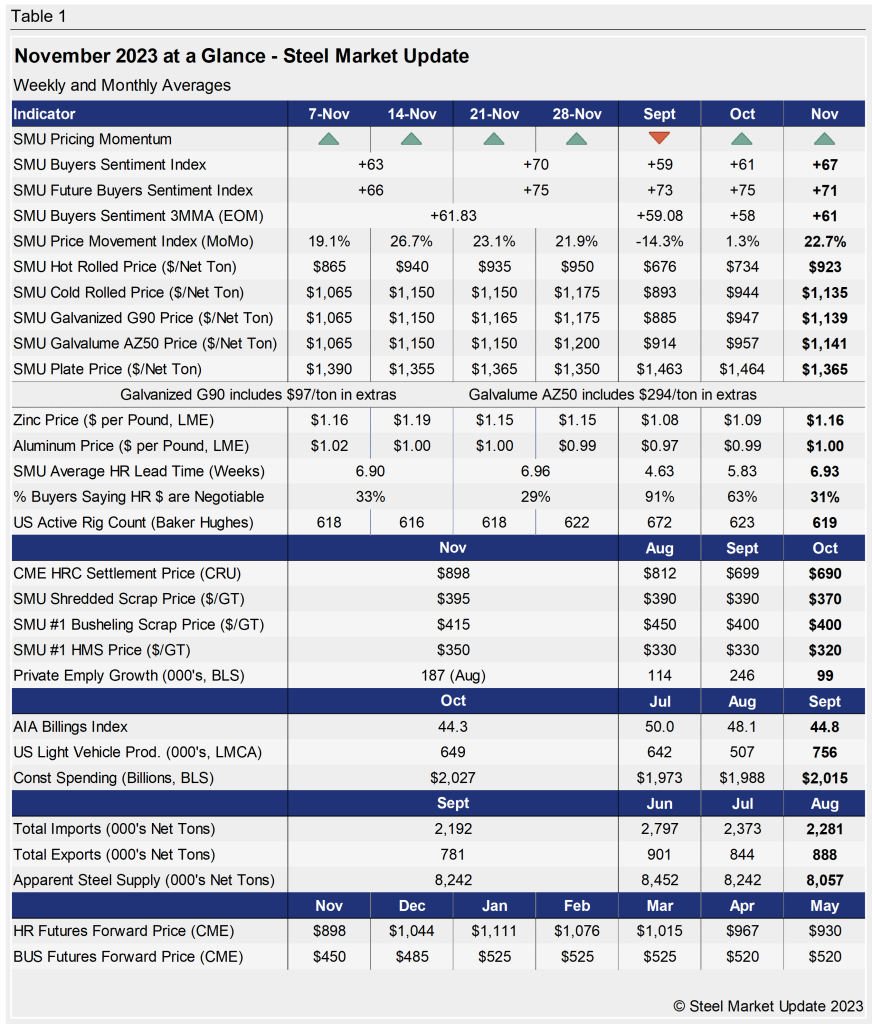SMU Data and Models
SMU's November at a glance
Written by David Schollaert
December 5, 2023
Steel prices continued to rally last month on the back of repeated mill price increases after tags reached a 2023 low of $645 per ton in late September. Hot-rolled coil (HRC) prices ended November at an average of $923 per ton ($46.15 per cwt), rising by $140 per ton during the month.
The SMU Price Momentum Indicator for sheet products continued pointing Higher throughout November after shifting from the Lower in September. The trend remained in place as tags kept rallying in response to repeated mill price hikes throughout November.
The Price Momentum Indicator on plate, which had been pointing lower since September, shifted to Higher largely in response to mill increase notices at the close of the month. Despite the improvement, signs of weakness due to waning demand persist.
Raw material prices have fluctuated somewhat but were again mostly sideways last month, except for scrap. Scrap prices improved on average in November, up between $15-30 per ton. Despite some movement mid-way through the month, zinc and aluminum spot prices were largely stable, remaining within historical levels. You can view and chart multiple products in greater detail using our interactive pricing tool here.
The SMU Steel Buyers Sentiment Index remained positive and continued to recover a bit, edging up during the month. Current Buyers Sentiment rose from +61 in October to +67 on average in November. Future Sentiment hovered at an average of roughly +71, down slightly from the prior month’s reading of +75.
Our Steel Buyers Sentiment 3MMA Index (measured as a three-month moving average) had been eroding over the past four months, falling to +58 in October, but recovered to +61 on average last month.
Hot rolled lead times averaged 6.93 weeks in November, up from 5.83 weeks the month prior. SMU expects lead times to hover around current levels, but market chatter suggests they could increase a bit more through December and into the first quarter of 2024 as inventory management takes precedence at the year-end. A history of HRC lead times can be found in our interactive pricing tool as well.
About 31% of HRC buyers reported in November that mills were willing to negotiate on prices, down noticeably from roughly 63% in October as mills drove prices higher.
Key indicators of steel demand are still showing some signs of weakness overall and are nowhere near the bullish levels some had shown earlier in the year. While there are some backlogs in the energy and construction sectors, and the UAW strike on Detroit’s “Big Three” automakers ended, demand in December and into early 2024 seems controlled, especially as buyers appear to be pushing back on a bit on the most recent round of mill price hikes.
See the chart below for other key metrics for November:


David Schollaert
Read more from David SchollaertLatest in SMU Data and Models

SMU Survey: Sheet lead times ease further, plate hits one-year high
Steel buyers responding to this week’s SMU market survey report a continued softening in sheet lead times. Meanwhile, plate lead times have moderately extended and are at a one-year high.

SMU Survey: Buyers report more price flexibility from mills
Nearly half of the steel buyers responding to this week’s SMU market survey say domestic mills are showing increased willingness to negotiate pricing on new spot orders. This marks a significant shift from the firmer stance mills held in prior weeks.

SMU Survey: Buyers’ Sentiment Indices fall
Current Sentiment Index dropped six points to +42 this week compared to two weeks earlier. It has fallen in every successive survey since reaching a 2025 high of +66 on Feb. 19.

March service center shipments and inventories report
Steel service center shipments and inventories report through March 2024.

Apparent steel supply contracts in February
The amount of finished steel that entered the US market in February receded from January’s peak, according to our analysis of Department of Commerce and American Iron and Steel Institute (AISI) data.
